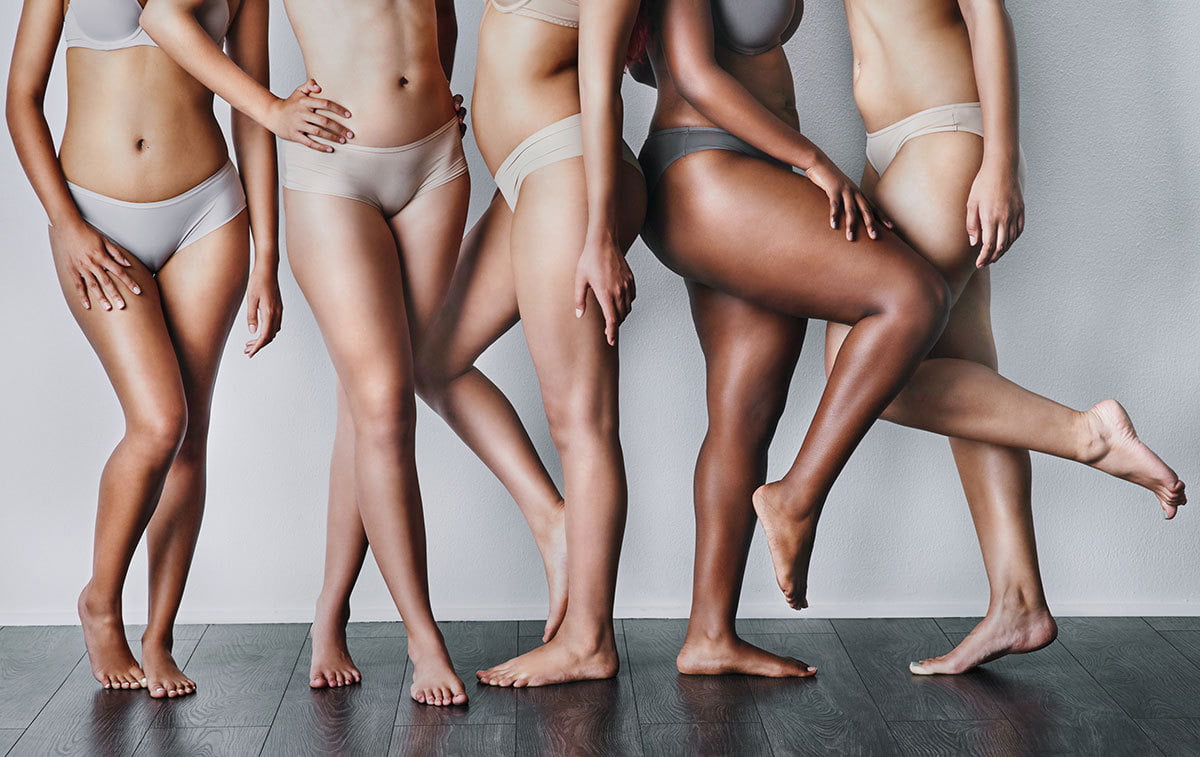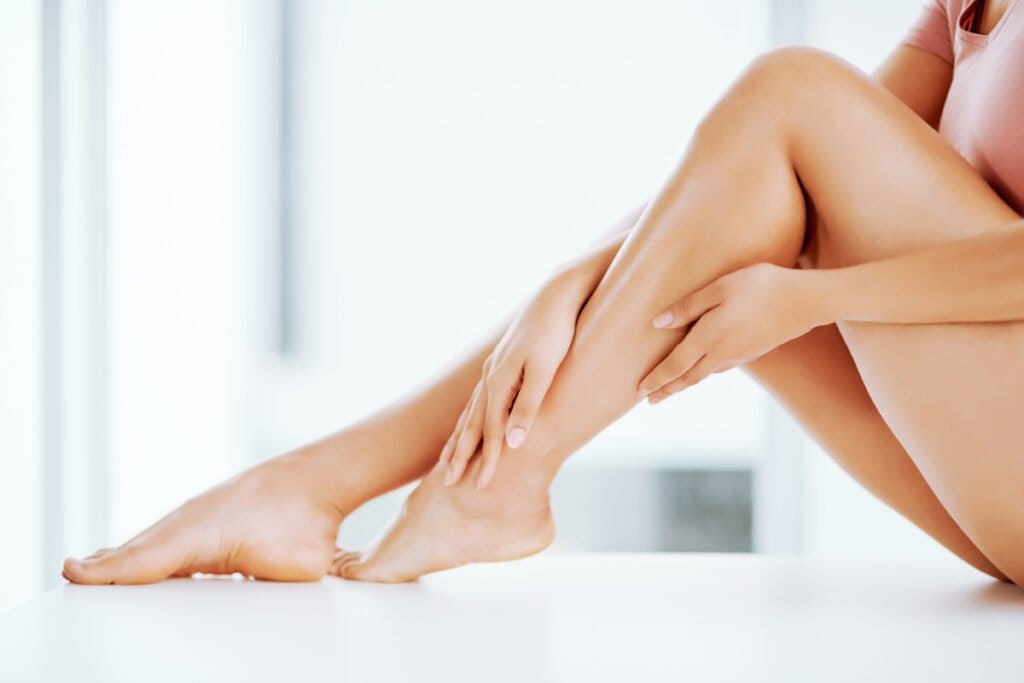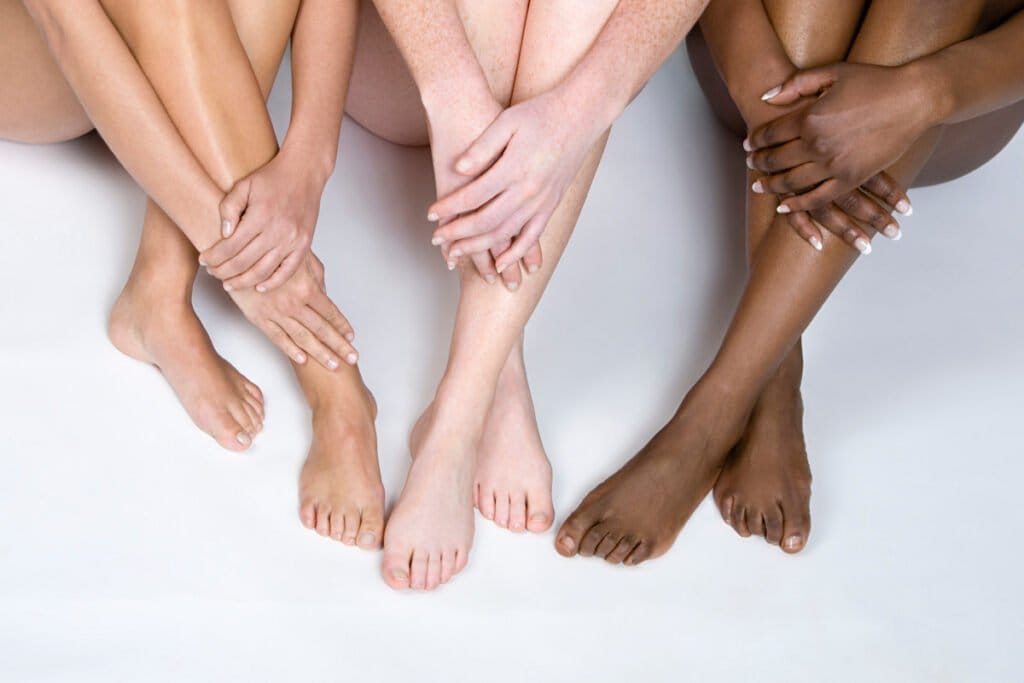I don’t like the shape of my legs. What procedures can help?

There are several procedures that can help patients improve and better enjoy the shape of their legs. That said, knowing what changes will help your legs look more harmonious can be tricky, so today we’re taking a deep dive into the subject of leg aesthetics, starting with the components of shapely legs, followed by solutions.
Here are some components of shapely legs:
- Buttock height and projection
- Well-proportioned thighs
- Good overall leg alignment
- Defined knees
- Rounded calves
- Tapering ankles
- Smooth, unblemished leg skin
Here are the best procedures to enhance the look of your legs:
- Want longer looking legs?
- Dislike your thighs?
- Unhappy with your knees?
- No luck developing your calves?
- Concerned about cankles?
- Skin issues marring your legs?
Components of shapely legs
Understanding what goes into the look of shapely legs can help you more easily identify what bothers you about your gams. While it is important to recognize that there is no one ideal leg shape, and personal preferences influence perceived attractiveness, the following factors all play a strong part in the appearance of your legs:
Buttock height and projection
Buttock height and projection are essential because the buttock is the root of the leg. If there isn’t a good balance, the front of the thigh can look overly large when it is actually fit and attractive. Additionally, leg length will appear suboptimal unless the buttock height has a clear ending. In other words, you must be able to see where the buttock ends and the lower back begins to appreciate the true height of the leg.
Well-proportioned thighs
When the large, beautiful quadricep muscle paired with the bicep femoris (also known as the hamstring muscle) is visually more prominent than any inner and outer thigh fat pockets, it creates a very shapely leg line. Well-developed inner thigh muscles (the abductor muscle group) are another attractive, though less commonly seen, feature.
A few words on “thigh gap”: Cosmetic surgeons are commonly asked about ways to enhance the appearance of a thigh gap. However, it is not always possible, nor is it necessarily advisable, to create space where it was not genetically designed to exist. Consider that your skeleton, specifically the insertion of the femur bone at the pelvis, has a strong influence on the distance between your thighs. Further, for those who have significant inner thigh muscles, achieving a thigh gap is likely to be an unrealistic goal. The good news is that many aesthetic surveys have demonstrated that touching inner thighs are considered to be aesthetically appealing. (These surveys also tend to show that having a small space for the transmission of light just above where the inner thighs touch is an attractive feature, and, in contrast with a thigh gap, this is more likely to be an achievable refinement.)
Good overall leg alignment
Proper vertical alignment of the upper leg bone, the femur, with the primary lower leg bone, the tibia, will help your legs look longer. Variations in leg alignment are not just an aesthetic issue: misalignment can lead to orthopedic problems, such as genu valgum (knocked knees), or genu varum (bowed knees).
Defined knees
Some patients have diet- and exercise-resistant fat that collects on the inner or medial knee. As with the thigh, a classically attractive knee appearance exists when the front to back measurement is greater than the width.
Rounded calves
The transition from the knee to the calf is likely to look particularly attractive when the calf adds visible curves to the back and sides of the leg. This calf fullness should peak about one third of the way down the lower leg, then aggressively taper as it approaches the ankle area.
Tapering ankles
Generally, the ankle area has very little subcutaneous fat, and its slimness creates an elegant contrast with the calf.
Smooth, unblemished leg skin
Skin appearance is important, too, as irregularities can distract from a generally attractive leg shape. Many patients are frustrated by cellulite, which is the result of myo and fasciocutaneous ligaments that tether the skin to the underlying muscles. (As skin becomes lax or fat expands in between these connections, the skin takes on the quilted appearance of cellulite.) Sun damage and discolorations of the legs can also take away from their natural beauty. Varicose veins and unwanted body hair round out the list of common skin appearance concerns.
Armed with an understanding of these aesthetic considerations, you can better determine which procedures will be most suitable for improving the appearance of your legs.

Procedures that can enhance the look of your legs
Want longer looking legs?
Consider increasing buttock definition with liposuction and/or fat transfer
As we mentioned earlier, having defined buttocks can help the legs appear longer. Liposuction can be very helpful to enhance the upper border of the buttock as well as its lower border. Fat grafting, wherein your liposuctioned fat is purified and placed in a new location, can selectively increase the projection of your backside. These procedures will collectively help define where your legs end and your buttocks begin, emphasizing the attractiveness of each.
Dislike your thighs?
Liposuction is the go-to solution for thigh shaping
When it comes to the outer thigh, most people prefer a fairly straight line, or a gentle curve, because dramatic “saddle bags” disrupt the appearance of the leg line. Fat reduction of the outer and inner thigh can help restore balance between the width and projection of the thigh. As previously noted, it’s important to be realistic about creating space between the thighs, but we can still increase the shapeliness of this area even if your anatomy doesn’t support the “thigh gap” look.
A thigh lift can repair sagging
If you have lost weight and been left with skin that does not tightly conform to the underlying musculature of your legs, a thigh lifting procedure is likely to be recommended. (A thigh lift may be combined with a body lift if the sagging extends to the buttocks and lower torso.) Removing excess skin won’t just help the appearance of your legs: it is likely to make movement and exercise more comfortable.
Unhappy with your knees?
Liposuction or Kybella injections can help
Removing excess fat in the knee area won’t just change the appearance of your knees: it also can also make the legs appear longer. As the inner knee area is a relatively small fat compartment, nonsurgical treatments such as the injectable Kybella may be considered.
No luck developing your calves?
Calf implants can help
For those patients who struggle with calf volume, calf implants are the preferred method of enhancement, offering dependable and shapely results that will complement the entire length of your legs.
Concerned about cankles?
After ruling out health concerns, look to liposuction
While swollen ankles can be indicative of health conditions, if your ankles have never been as slender as you’d like due to excess fat deposits, liposuction is a great way to contour the lower portion of the leg and ankles.

Skin issues marring your legs?
Cellulite treatment
The treatment of cellulite remains frustrating and elusive. If you cut the fascia cutaneous ligaments with a specialized liposuction cannula called a Toledo tip cannula or use an under-the-skin energy device such as direct- or side-firing laser, the attachments tend to return over time. Subcutaneous fat can be reduced in the area of cellulite; however, this does not solve the problem of the ligaments. Skin can be periodically tightened through energy devices such as Thermage or Ulthera, but these treatments typically need to be repeated over time.
Preventing and treating sun damage
Sun damage is best treated with physically-based sunscreens as well as judicious use of tretinoin and hydroquinone, as well as superficial and very carefully applied medium-depth chemical peeling. Phototherapy, as in intense pulsed light or broadband light devices, can be helpful, as well.
Treating spots, varicose veins, and unwanted hair
Laser vein treatment and laser hair removal are two popular non-surgical options for improving the appearance of legs. Targeted discoloration, such as reds, blues, and browns, may be treated with a pulsed dye laser, alexandrite laser, and near infrared devices. Very small varicose veins may be treated with external lasers such as an alexandrite. Medium-size vessels are often effectively treated with sclerotherapy, whether Asclera (polidocanol) or hypertonic saline. The treatment of unwanted hair in the leg area is rather straightforward if the hair is dark. However, for dark skinned individuals or even fair-skinned individuals who have fine vellus hairs, special consideration and technology is important.
Dry skin with rough skin texture
It’s important to take care of the skin on your body like you do the skin on your face! Following a consistent skincare routine, meaning washing, exfoliating, moisturizing, and wearing SPF, on your legs can go a long ways towards improving their appearance.
Consult with a board certified cosmetic surgeon to learn about all of your leg contouring options
As you can see, there are many options available to patients seeking improvement of their legs. Your cosmetic surgeon can make an effective, customized treatment plan through understanding what specific aspects of your lower body that you would like to improve. With the exception of the treatment of cellulite, which is admittedly very frustrating for both the patient and the surgeon, long-term patient satisfaction with the above procedures are very high.
Schedule a consultation with Dr. Sobel today!If you are in the greater Seattle area, or are willing to travel, we would love to meet with you and help you get the legs of your dreams! Give Anderson Sobel Cosmetic Surgery a call or contact us online to schedule a consultation with board certified cosmetic surgeon Dr. Sobel and learn about all of your leg contouring options.
2 Comments Posted to "I don’t like the shape of my legs. What procedures can help?"
I just wanted to say thank you for thoroughly covering all of the information about legs. I have been looking for years because I dislike my leg shape, but I live in Dallas, Texas area.
I am a 62 year old female. Have been lucky & blessed to have great legs, though now my legs have started to look really bad. Age related? Of course!! Please help me find a good Doctor in SA, Tx., to help me find either procedures or ways to keep what I’ve got left of my fortunate good genes.
Thank you for your attentiveness.
Natalia